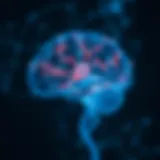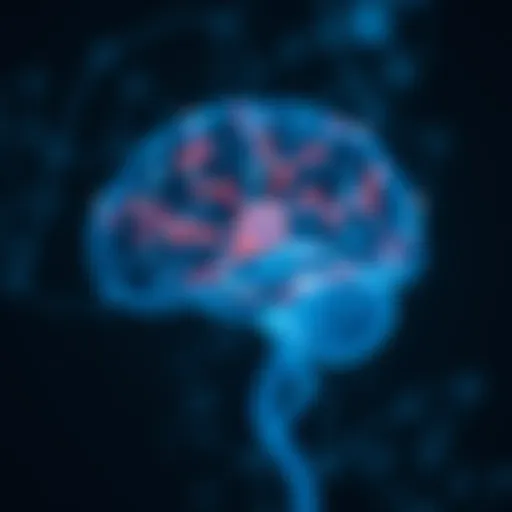Medications for Amyotrophic Lateral Sclerosis: Overview


Intro
Amyotrophic Lateral Sclerosis (ALS) is a complex and progressive neurodegenerative disease with profound implications for individuals diagnosed with the condition. It primarily affects motor neurons, leading to muscle weakness, atrophy, and ultimately paralysis. Understanding the medications used to manage ALS is crucial, not just for healthcare professionals, but also for patients and caregivers navigating treatment options. This article aims to provide a thorough overview of the pharmaceutical landscape associated with ALS treatment.
Overview of Research Topic
Brief Background and Context
ALS was first described in detail by the French neurologist Jean-Martin Charcot in the late 19th century. Since then, research into its pathophysiology and treatment has grown significantly. Currently, two main drug therapies, riluzole and edaravone, are approved in various countries for managing ALS. Their roles in altering disease progression have been important in clinical studies. Alongside traditional medications, the exploration of emerging therapies presents a hopeful avenue for ALS research and patient management.
Importance in Current Scientific Landscape
The significance of understanding ALS treatments is not limited to the clinical aspects. There is a growing need for comprehensive research into patient-tailored solutions and symptom management. As research progresses, the integration of multidisciplinary approaches involving specialists in neurology, physical therapy, and nutritional counseling becomes increasingly important. This broadens the scope of care, potentially improving patient quality of life.
Methodology
Research Design and Approach
A systematic review of available literature, clinical trials, and meta-analyses forms the foundation of this article. The research examines the efficacy and safety profiles of established ALS medications, along with recent developments in the field.
Data Collection Techniques
Data was gathered from medical journals, clinical databases, and reputable health organizations. This included peer-reviewed studies focusing on drug effectiveness, side effects, and patient response. Both historical and current data contribute to a comprehensive analysis.
"A well-rounded understanding of ALS medications requires a continual review of evolving research and practices."
Through this exploration, the intention is to provide clarity and accessibility in what can often be an overwhelming landscape for both medical professionals and patients.
Preface
The exploration of medications used for Amyotrophic Lateral Sclerosis (ALS) is essential for understanding the landscape of treatment for this complex neurodegenerative disease. ALS affects motor neurons, leading to muscle weakness and atrophy, ultimately impacting patients' mobility and ability to perform daily activities. This progressive nature of the illness presents significant challenges not only for those diagnosed but also for their caregivers and healthcare providers.
In this article, we will delve into various aspects of ALS medications, covering their mechanisms, efficacy, and potential side effects. Understanding these factors is critical for clinicians and patients alike. Effective treatment strategies can greatly improve the quality of life for those affected by ALS, making it imperative to stay informed about the latest developments and recommendations in pharmacological treatments.
Additionally, ALS management often requires a multidisciplinary approach. Thus, recognizing the role of different healthcare professionals in medication management is pivotal. This can include neurologists, nurse practitioners, pharmacists, occupational and physical therapists, and nutritionists, among others. The intricate interplay between the patient and care team can influence treatment outcomes significantly.
Moreover, the article discusses emerging therapies and future directions for research. As the scientific community continuously seeks more efficient treatments, new options may reshape the landscape of ALS management.
The increasing availability of information surrounding ALS treatments enables informed decision-making by patients and their families. This leads to better therapeutic strategies and improved results overall. Therefore, understanding the current medications, their benefits, and their limitations is crucial for anyone involved in ALS care.
In summary, this overview focuses on the medications used for ALS, offering insights that extend to both healthcare professionals and individuals seeking deeper knowledge about ALS treatment.
Overview of ALS
Understanding Amyotrophic Lateral Sclerosis (ALS) is crucial when discussing medications for this condition. ALS, commonly known as Lou Gehrig's disease, is a progressive neurodegenerative disorder that primarily affects motor neurons in the brain and spinal cord. The relevance of this overview lies in comprehending how ALS impacts the nervous system and the implications for treatment options. By recognizing the features of this disease, health professionals can make better-informed decisions regarding therapies.
Definition and Classification
ALS is classified as a motor neuron disease, characterized by the degeneration of both upper motor neurons and lower motor neurons. To be classified as ALS, patients usually exhibit symptoms like muscle weakness, atrophy, and spasticity. These symptoms arise due to the gradual loss of motor neurons, leading to impaired voluntary muscle control.
Different disease types exist, including sporadic and familial forms. The sporadic form represents about 90-95% of cases, while familial ALS, linked to genetic mutations, accounts for the remaining 5-10%.
Pathophysiology
The pathophysiological mechanisms of ALS are complex and not yet fully understood. However, researchers have identified several key factors involved in the progression of the disease. These include protein aggregation, oxidative stress, and mitochondrial dysfunction.
Once motor neurons start to degenerate, there is a decrease in the ability to send signals to muscles, which results in muscle weakness. The neuronal death leads to increased excitotoxicity, which refers to the damage caused by excessive stimulation of neurons. This triggers an inflammatory response in the central nervous system, further accelerating neuronal loss.
Epidemiology


Epidemiological studies reveal that ALS affects around 2 per 100,000 individuals annually. The incidence varies based on geographic factors, with a higher prevalence in North America and parts of Europe. Men are also more likely to develop ALS than women, with a ratio of about 1.5:1. The average age of onset ranges from 55 to 75, though ALS can occur in younger individuals.
In summary, an extensive understanding of ALS is essential for selecting appropriate medications and therapies. Recognizing the definition, pathophysiology, and epidemiological factors contributes to a robust approach to managing this debilitating condition.
Standard Pharmacological Treatments for ALS
Standard pharmacological treatments for Amyotrophic Lateral Sclerosis (ALS) serve as vital components in managing the disease. These medications aim to slow the progression of the illness and alleviate its symptoms, providing patients with a better quality of life. Understanding these treatments is crucial for both healthcare providers and patients alike. The primary medications, Riluzole and Edaravone, form the cornerstone of ALS treatment. They have distinct mechanisms, efficacy, and side effects that should be considered when developing a treatment plan.
Riluzole
Mechanism of Action
Riluzole operates through a unique mechanism by inhibiting the release of glutamate, a neurotransmitter that can be toxic to motor neurons in excessive amounts. By reducing glutamate levels, Riluzole potentially decreases excitotoxicity associated with ALS. This characteristic makes it a preferred choice in managing ALS, as it addresses a key pathological feature of the disease, thus contributing to its effectiveness. Its innovative approach can delay the onset of significant disability in patients, which is a critical consideration in ALS management.
Efficacy and Outcomes
Riluzole has been shown to extend survival and time to tracheostomy in ALS patients. Clinical trials reported that patients taking Riluzole experienced a modest delay in symptom progression. This key characteristic of improving longevity makes Riluzole a significant option in ALS management. However, the effect size is modest, and it is not a cure, necessitating further examination of patient needs and expectations when starting this treatment.
Side Effects and Management
Some side effects of Riluzole include nausea, dizziness, and liver enzyme elevation. Monitoring liver function is a vital aspect of managing patients on this medication. The potential side effects of Riluzole highlight the importance of careful management and patient education regarding what to expect while on therapy. Understanding these elements can enhance treatment adherence and overall patient experience.
Edaravone
Mechanism of Action
Edaravone works primarily as a free radical scavenger. Its ability to neutralize oxidative stress is advantageous for patients suffering from ALS. By protecting cells from oxidative damage, Edaravone addresses another crucial aspect of ALS pathology. This mechanism sets it apart from Riluzole. Edaravone is a beneficial option for those susceptible to oxidative injury, thereby providing an additional layer of protection for motor neurons in patients.
Efficacy and Outcomes
Research shows that Edaravone treatment may slow the decline in physical function over time. Patients receiving Edaravone showed improvements in daily activities compared to those on placebo. Its efficacy in enhancing the quality of life distinguishes it as a significant advancement in ALS pharmacotherapy. However, the variability in response among patients calls for personalized treatment considerations in clinical practice.
Side Effects and Management
The side effects associated with Edaravone are generally mild and can include headache and bruising. While the overall tolerability is good, clinicians need to remain vigilant about any allergic reactions. An important aspect of managing patients on Edaravone includes proper patient education on what side effects to monitor. This knowledge empowers patients to communicate effectively about their experiences during treatment.
Symptomatic Treatments
Symptomatic treatments play a crucial role in managing Amyotrophic Lateral Sclerosis (ALS). The progressive nature of ALS means that patients experience a variety of symptoms that can significantly impact their quality of life. By addressing these symptoms effectively, healthcare providers can improve comfort and functionality in day-to-day activities.
Understanding the specifics of symptomatic treatments helps both patients and caregivers navigate the complexities of this disease. This section highlights key areas of focus: the management of muscle spasticity, pain control, and treatment of sialorrhea. Each area has distinct medications that provide relief and facilitate better patient outcomes.
Management of Muscle Spasticity
Muscle spasticity is a common issue for ALS patients. It can lead to discomfort, reduced mobility, and difficulty with daily tasks. Two primary medications for muscle spasticity include Baclofen and Tizanidine.
Baclofen
Baclofen is a muscle relaxant that acts on the central nervous system. This medication works by inhibiting the transmission of nerve signals in the spinal cord. This action helps reduce muscle stiffness, making movement easier. Baclofen is frequently prescribed due to its relatively favorable profile in terms of efficacy and tolerability.
A significant characteristic of Baclofen is its capacity to provide substantial spasticity relief with appropriate dosaging. An advantage of Baclofen is its availability in oral and intrathecal forms. Intrathecal delivery allows for lower doses to be used with improved effectiveness, although this method involves a more invasive procedure.
However, there can be disadvantages. Baclofen may cause side effects such as sedation or weakness, especially at higher doses. Adjusting the dosage is important to minimize these side effects while still achieving desirable outcomes.
Tizanidine
Tizanidine is another muscle relaxant used in the management of spasticity within ALS. It primarily acts as an alpha-2 adrenergic agonist. Tizanidine helps reduce muscle tone by inhibiting excessive nerve impulses. It is often favored for its sedative properties, which can also aid in improving sleep quality for patients.
One key feature of Tizanidine is its fast onset of action. Patients may experience relief within a short time after dosing. Its flexibility in dosing allows for titration to find the appropriate balance between efficacy and side effects.
Despite these advantages, Tizanidine may cause side effects, including dry mouth, drowsiness, and hypotension. Awareness of these potential side effects is critical in managing treatment and ensuring patient safety.


Pain Management
Pain management is a vital component of ALS care. It addresses discomfort that can arise from muscle cramps, neuropathic pain, and general body aches. Gabapentin and Tramadol are two medications commonly used in this area.
Gabapentin
Gabapentin is primarily known as an anticonvulsant medication but has proven effective in treating neuropathic pain as well. This medication works by modulating the release of excitatory neurotransmitters, which contributes to reduced pain perception. Gabapentin is often a first-line treatment due to its effectiveness and comparative safety.
A key characteristic of Gabapentin is its gradual titration, allowing healthcare providers to minimize side effects while enhancing the pain-relieving effects. It is well-tolerated in many patients, making it a common choice.
However, some patients may experience side effects like dizziness, fatigue, or ataxia. Continuous evaluation of the patient's response is needed to adjust dosaging safely.
Tramadol
Tramadol is an analgesic that combines opioid and non-opioid mechanisms. It works by binding to mu-opioid receptors and inhibiting the reuptake of norepinephrine and serotonin, contributing to its pain-relieving properties. Tramadol is often utilized when stronger analgesics are not advisable.
One unique feature of Tramadol is its dual approach to pain relief. This multifaceted mechanism can be particularly beneficial in a condition like ALS, where patients may present with complex pain syndromes.
That said, Tramadol can also present risks, particularly concerning dependency and side effects such as nausea or constipation. Its use requires careful monitoring, especially in patients with a history of substance use disorders.
Management of Sialorrhea
Sialorrhea, or excessive salivation, is another symptom observed in ALS patients. It can lead to social discomfort and hygiene issues, making management essential. Atropine and Glycopyrrolate are two effective medications for this purpose.
Atropine
Atropine is an anticholinergic agent that reduces secretions in the body. In the context of sialorrhea, it helps decrease saliva production by blocking the action of acetylcholine on salivary glands. This property makes Atropine a popular choice for managing excessive salivation.
The main characteristic of Atropine is its rapid onset of action. It can be administered in various forms, including sublingual drops or transdermal patches, providing flexibility for patient needs.
Nevertheless, Atropine may cause side effects such as dry mouth and blurred vision. These effects necessitate careful monitoring and adjustment of therapy based on patient tolerance.
Glycopyrrolate
Glycopyrrolate is another anticholinergic medication used to manage sialorrhea. Similar to Atropine, it inhibits salivation but has a longer duration of action. Its use is often prevalent in managing chronic sialorrhea in ALS patients.
The key characteristic of Glycopyrrolate is that it can be taken orally or injected, providing versatility in administration. Glycopyrrolate is generally well-tolerated and offers a good balance between efficacy and side effects.
Despite its advantages, potential side effects include constipation and urinary retention. Awareness of these risks is essential to ensure that Glycopyrrolate is used safely and effectively.
The Role of Multidisciplinary Care
Multidisciplinary care is essential in the management of Amyotrophic Lateral Sclerosis (ALS). The complexity of ALS necessitates teamwork among various healthcare professionals to address the diverse needs of patients effectively. This approach combines the expertise of neurologists, nurses, occupational therapists, speech-language pathologists, and nutritionists who work together to create a comprehensive care plan. Such collaboration not only enhances clinical outcomes but also improves the quality of life for patients.
It is important to note that ALS affects individuals differently, leading to variations in symptoms and progression. Therefore, a singular approach may not suffice. A multidisciplinary team can tailor interventions that focus on managing specific symptoms, facilitating better overall care. For instance, while some patients may struggle with respiratory issues due to weakened muscles, others may experience significant speech difficulties. Coordinating care from these various specialists ensures that all aspects of the patient's needs are effectively addressed.
Healthcare Provider Collaboration
Healthcare provider collaboration is a cornerstone of multidisciplinary care for ALS patients. Effective communication among team members is critical. By sharing insights and updates on a patient's condition, providers can make informed decisions. This collaboration can involve regular meetings to discuss patient progress, share observations, and adjust treatment plans accordingly.
Some key aspects of collaboration include:
- Improved Diagnosis and Treatment: A combined knowledge base aids in the timely identification of complications, ensuring appropriate interventions are implemented sooner.
- Defining Roles: Clarifying the responsibilities of each provider promotes efficiency. Each member knows what they need to focus on, minimizing overlap and confusion.
- Patient-Centered Care: Involving patients and their families in care decisions enhances adherence to treatment plans and respects individual preferences and priorities.
Overall, healthcare provider collaboration significantly impacts the management of ALS, leading to more cohesive care delivery.
Importance of Occupational and Physical Therapy
Occupational and physical therapy play crucial roles in the care of ALS patients. These therapies are not just means of assisting with daily activities; they also strive to maintain independence for as long as possible.
- Physical Therapy: A physical therapist works with patients to design exercise regimens that focus on strength, flexibility, and balance. These exercises can help maintain mobility and reduce the risk of falls, which can be detrimental for ALS patients. Regular movement may also alleviate some muscle stiffness and spasticity.
- Occupational Therapy: An occupational therapist evaluates a patient's ability to perform everyday activities. They may recommend adaptive devices to assist with tasks like dressing or cooking. These modifications can significantly enhance the patient's independence.


Engaging in these therapies can combat feelings of helplessness that often accompany progressive diseases. They empower patients by giving them tools to manage their physical capabilities and navigate their daily lives more effectively.
"A multidisciplinary approach not only addresses the medical treatment of ALS, but also preserves the dignity and quality of life for those affected."
Emerging Therapies in ALS
Emerging therapies in ALS represent crucial advancements in the ongoing effort to improve the management of this complex neurodegenerative disease. Although current medications, like Riluzole and Edaravone, play significant roles in treatment, ongoing research seeks to explore additional avenues for intervention. Emerging therapies aim to not only alleviate symptoms but also address the underlying mechanisms of the disease. This section discusses some of these promising approaches, including gene therapy and stem cell therapy.
Gene Therapy Approaches
Gene therapy approaches are gradually gaining attention in the realm of ALS treatment. This method focuses on modifying or manipulating genes to treat or prevent disease. In the context of ALS, gene therapy aims to correct genetic mutations responsible for the disorder or to deliver therapeutic genes that can potentially slow disease progression.
Currently, researchers are investigating different strategies for gene therapy in ALS. One notable approach is the use of viral vectors to deliver functional copies of genes into affected motor neurons. By introducing these therapeutic genes, scientists hope to restore normal cellular function and protect against neurodegeneration. For instance, efforts with Zolgensma showed promise in addressing specific mutations in children with spinal muscular atrophy, an associated condition.
Another emerging strategy involves RNA interference technology, which targets and silences harmful mutations at the RNA level. This approach has shown potential in preclinical studies, with some researchers suggesting it could lead to significant improvements in motor neuron function.
Gene therapy for ALS carries unique possibilities, but it also has challenges. These include ensuring targeted delivery of genetic material and minimizing the risk of adverse reactions. As research progresses, it's essential to balance the potential benefits against these risks. Future studies will hopefully provide valuable insights into the long-term efficacy and safety of these treatments.
Stem Cell Therapy
Stem cell therapy has garnered interest as a potential treatment modality for ALS. This approach involves using stem cells to restore or replace damaged nerve cells in patients. The rationale behind using stem cells is to harness their unique properties—specifically, their ability to differentiate into various cell types and promote healing.
Several types of stem cells are being explored, including embryonic stem cells, induced pluripotent stem cells, and mesenchymal stem cells. Each type has distinct characteristics and potential applications that make them appealing for ALS therapy. For instance, mesenchymal stem cells are known for their anti-inflammatory and immunomodulatory properties, which could benefit ALS patients experiencing neuroinflammation.
Clinical trials have been initiated to explore the safety and efficacy of stem cell therapy in ALS. These trials aim to determine whether stem cells can improve motor function or prolong survival in individuals with this debilitating disease. Results from early-phase trials show modest improvements in symptoms, but further research is crucial for understanding the full potential of this approach.
However, there are important considerations regarding stem cell therapy. Issues such as ethical concerns regarding stem cell sources, the complexity of administration, and long-term outcomes need to be carefully evaluated. As researchers continue to investigate stem cell therapies, it is vital to develop standardized protocols and clear guidelines to ensure patient safety and treatment efficacy.
"Emerging therapies like gene and stem cell approaches could redefine the treatment landscape for ALS, providing new hope for patients and families."
In summary, the exploration of emerging therapies such as gene therapy and stem cell therapy signifies a move towards more innovative and targeted treatment options for ALS. While these therapies are still under research, they embody a critical step towards understanding and potentially altering the course of this devastating condition. The combination of scientific exploration and compassionate care will be essential as the field advances.
Research Trends and Future Directions
Research in Amyotrophic Lateral Sclerosis (ALS) is rapidly evolving, marked by innovative approaches and a growing understanding of the disease. The importance of this area lies in its potential to uncover novel treatments and strategies to manage symptoms effectively. As the landscape of medical research continues to change, it is crucial to explore current trends and emerging directions to enhance patient outcomes. This section highlights significant developments and considerations for the future.
Current Clinical Trials
Clinical trials are pivotal in determining the safety, efficacy, and practicality of new ALS treatments. Researchers around the world are committed to exploring various avenues in the fight against this devastating disease. A few key aspects include:
- Biomarker Identification: Understanding biomarkers is critical for monitoring disease progression and treatment responses. Current studies are focusing on various biological indicators that might predict disease course or treatment benefits.
- New Pharmacological Agents: Trials are investigating various agents beyond traditional medications. Examples are trials exploring compounds like Masitinib, which inhibits immune activation in ALS.
- Gene Therapy Approaches: Clinical trials on gene therapies show promise in altering underlying genetic causes of ALS. These trials aim to leverage techniques like CRISPR to correct mutations at a fundamental level.
"The future of ALS research holds great promise, emphasizing the need for multidisciplinary approaches and collaborative efforts."
With multiple ongoing clinical trials, registries for ALS patients are proving beneficial. They provide not only networking opportunities for researchers but also an essential database for patient outcomes.
Potential Areas for Future Research
As the understanding of ALS improves, several areas merit deeper investigation to optimize current treatments and discover new ones:
- Neuroprotective Strategies: Developing methods to protect motor neurons from degeneration is vital. Research focusing on antioxidants and neurotrophic factors may reveal new protective approaches.
- Role of the Immune System: Exploring how the immune system contributes to ALS progression may lead to immunomodulatory therapies that could mitigate neuroinflammation.
- Personalized Medicine: There is a pressing need for research into personalized treatment protocols based on genetic predispositions. Understanding individual responses to therapies can refine treatment methods.
- Longitudinal Studies: Forming comprehensive studies tracking ALS patients over long periods can provide insights into disease progression. This data can help identify factors associated with slower progression or improved quality of life.
With such opportunities for exploration, the future of ALS research looks to be promising. Emphasizing collaboration between clinicians, researchers, and patient advocates will enhance the impact of these efforts.
End
The conclusion of this article emphasizes the critical nature of medication management in Amyotrophic Lateral Sclerosis (ALS). With the complex interplay of neurodegeneration and symptomatology, understanding the pharmacological landscape is essential for effective treatment.
Key takeaways from the discussed sections highlight that while standard treatments such as Riluzole and Edaravone serve as the core therapeutic options, managing symptoms with additional medications can significantly improve a patient’s quality of life. Whether addressing muscle spasticity with Baclofen or managing pain through Gabapentin, these treatments play a crucial role in comprehensive care strategies.
Moreover, the ongoing exploration of emerging therapies, including gene therapy and stem cell approaches, points to a future where the management of ALS could enhance patient outcomes significantly. The integration of multidisciplinary care—incorporating professionals across fields—underscores the importance of a holistic approach in addressing all aspects of ALS.
In summary, the conclusion reinforces the idea that ongoing education, research, and collaboration among healthcare providers are pivotal. For patients and their families, knowledge of various medications and their implications supports informed decision-making. Therefore, attention to the pharmaceutical development landscape in ALS remains essential, guiding hope for those affected by this condition.
"A deep understanding of available treatments can empower patients and enhance the overall management of ALS."
In reflection, this guide serves as a valuable resource for students, researchers, educators, and professionals, providing insights into the intricate medication approaches within ALS management. It calls for continuous learning and adaptation as new discoveries unfold.



